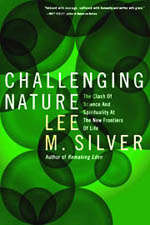|
published by Ecco/Harper Collins, 2006
|
|
Books
Presentations
Publications/Writings
Biography
Princeton Courses
|
 
Challenging Nature: The Clash of Science and Spirituality at the New Frontiers of Life
By Lee M. Silver. 444 pp. New York, Ecco, 2006. $26.95. ISBN 0-06-058267-7.Challenging Nature is a clearly written, trenchant defense of biotechnology against those who seek to limit the intentional control of nature and ourselves. Silver attacks the prohibition against "playing God," advocating instead the humanitarian use of biotechnology in medicine, nutrition, ecologic sustainability, and reproductive choices. He sees the opposition to control as rooted in unwarranted reverence for what is "natural," as opposed to "unnatural" human intervention. He shows how this reverence derives from religious and New Age notions of the immaterial soul, the Christian tradition of natural law, and the Gaia philosophy, according to which Mother Nature has our best interests at heart and so should not be tampered with. Humans should not usurp the inherently good natural order. Silver surveys the variety of beliefs in the soul and the sanctity of nature and their tenacious roots in human biology and culture. He observes that scientists have no need for such notions, which set the stage for a clash of worldviews one empiric and naturalistic, the other mystical and vitalist. As science progresses in its understanding, especially of consciousness and behavior, the concepts of soul and human essence have come under increasing pressure because they are no longer needed to explain ourselves to ourselves. Hence, there arises the backlash against science and technology, expressed as the injunction that we should leave some mysteries unplumbed. Silver describes how beliefs in the soul and the sacred natural order affect policy in domains such as abortion, cloning, genetic engineering, biodiversity, and the environment. In each case, purists with religious or spiritual agendas attempt to limit the scope of intentional control, which can rule out what many might consider legitimate options, such as terminating an unwanted pregnancy, conducting stem-cell research, and designing resource-efficient varieties of grain and livestock. The ideology of inviolable Nature thus has profoundly antihumanitarian consequences, according to Silver even, ironically, threatening the planet as a sustainable habitat. Silver's Promethean counterargument is that since science finds no natural perfection or divine imprimatur, whether in embryos, stem cells, seeds, or body plans, those opposing biotechnology cannot claim that we are violating nature when we go about controlling genomes and their expression. With regard to genetic engineering, Silver properly notes that once we dismiss the sanctity of the natural order, there is no reason to suppose that our current physical form is the final word on evolutionary wisdom. This view leaves the future wide open to what humans might become, given the accelerating pace of technological development.
Silver has his own deep reverence for nature, but in his wise, realistic view, nature includes even our capacity for intentional control. In remaking the world according to our deliberate designs, we are not violating Mother Nature but instead expressing a rather complex, recursive aspect of nature itself. Although a hard-boiled scientific rationalist, Silver's humanitarian hope is that "Biotechnology could alleviate human suffering, increase the quality of life in all societies, and maximize the health of the biosphere." Challenging Nature is a well-crafted argument that will help realize these hopes. |
Hover over or click on books to order from Amazon.com
|

